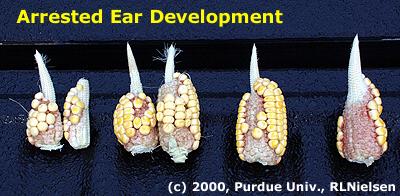![]() he coffeeshop talk always thins out as September
approaches and folks begin to gear up for fall harvest. Part of the reason for
the paucity (I learned a new word recently!) of gossip is that fewer people are
out walking their fields than earlier in the season. However, I want to raise a
couple of issues that I think are potentially important for corn growers to
consider before harvest begins.
he coffeeshop talk always thins out as September
approaches and folks begin to gear up for fall harvest. Part of the reason for
the paucity (I learned a new word recently!) of gossip is that fewer people are
out walking their fields than earlier in the season. However, I want to raise a
couple of issues that I think are potentially important for corn growers to
consider before harvest begins.
First of all, stalk rots and lodging are developing here and there throughout the state. In the fields that I have walked, the stalk rots are occurring in either random plants throughout the field or in many plants in smaller stressed areas of the field. The affected plants are dying prematurely, causing the grain to also mature earlier than expected.
At the onset of the disease, the affected plants exhibit a gray-green appearance as the plant tissue slowly dies, eventually bleaching out to a straw color as complete death occurs. Healthy or less infected plants nearby will still be green and healthier. In one field earlier this week, grain of healthy plants was at early to mid-dent stage while that of the diseased plants was already beginning to black layer. The affected plants eventually collapse at the lower nodes and fall over or lodge.
The bottom line from these observations is that farmers should be walking their fields during the next several weeks and determining whether stalk rots and the resulting stalk lodging are developing in individual fields. If so, then grain harvest should not be delayed any longer than necessary in order to avoid potentially significant mechanical harvest losses due to the severe stalk lodging.
Another interesting phenomenon I wanted to mention is that I have had a handful of reports in the last week or so of stunted or arrested ear development in plants that otherwise look normal. The affected ears are reminiscent of the so-called ‘beer-can ear syndrome’ that was widely observed back in 1992 and in some years since. I was recently in a variety plot where one hybrid in particular exhibited quite a few ears that were severely stunted.

Of the reports I have received, there appears to be no common herbicide link as a possible contributing cause. The reports have been too few to yet indicate whether the problem is occurring within a particular hybrid pedigree. Plants whose ear(s) are severely stunted will often turn a vivid purplish-red due to the imbalance between available photosynthate and the paucity (there’s that word again!) of kernels. If you’ve observed this problem, I would appreciate hearing about it.
More images of arrested ear development:
Image 1 || Image
2 || Image 3 ||
Image 4 || Image 5
Previously published articles on 'beer-can ear syndrome'